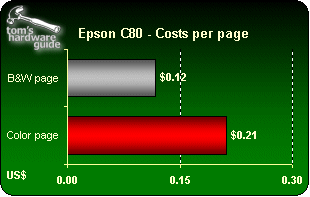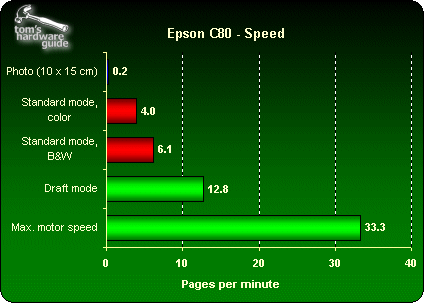Attractive Features: General-Purpose Inkjet Printers
Epson Stylus C80
Once the world leader in the inkjet market, Epson is now trying to work its way back to the top. This means overtaking not just HP, but also Canon, which recovered its health and reputation in 2001. In fact, one of the great Canon successes this year was the launch of the S600, to which Epson responded only this summer with the old Stylus Color 980. This came as no surprise, since the rumor had already gone round: Epson had adopted its rival's separate ink cartridge and put it on two of its models, the C70 (official replacement for the Stylus Color 880) and the C80 (replacement for the Stylus Color 980).
So here we have a configuration very like the Canon devices: fixed print-heads (along with all aging and clogging involved) and four cartridges (black; cyan, magenta and yellow).
The C80 was launched with a stupefying claim: it could print at a speed of up to 20 ppm in black! And if compared to the S630 and the Deskjet 930c, it would beat their respective speeds of "just" 17 and 15 ppm.
In practice, YES, the motor is very fast. Yes, it does print fast in color as well as black and white. But, NO, it does not reach the 20 ppm claimed with representative documents.
It also manifests its shortcomings in photo mode, which, like the C60, is very slow. A4 photos take more than 15 minutes, as opposed to the three minutes for the S630.
In terms of quality, there is nothing to add to the comments on the C60. There are a few flaws in character definition, the draft mode is unusable (really only useful for checking page layout), the colors are bright and the dots still visible in the photos. This printer ranks a bit below the Canon and HP models, but ahead of Lexmark. In photo mode, it has the usual failings of general-purpose printers: to brighten the hues and make images more vibrant, the printer adds magenta to yellow and cyan to magenta. Overall, the photos are a bit too red. It would be best to give it a trial run to optimize the color levels in the driver.
Paradoxically, the real weakness of the C80 turns out to be its separate cartridges, despite the marketing hype on this point. And there's the rub: Epson cartridges are 2 or 3 times more expensive than Canon's. Logically, they should print twice the number of pages in order to justify the high price. And this is by no means the case.
Get Tom's Hardware's best news and in-depth reviews, straight to your inbox.
The C80 is the first printer with 4 color cartridges and no print-head with a cost per page that is just as high as with print-head cartridges (HP and Lexmark). To compare favorably to Canon, the price of cartridges ought to be halved!
By the way, the ID chip on the earlier Stylus Photo cartridges is now in general use and is installed on those of the C80.
Current page: Epson Stylus C80
Prev Page Epson Stylus C60, Continued Next Page Epson Stylus C80, Continued


